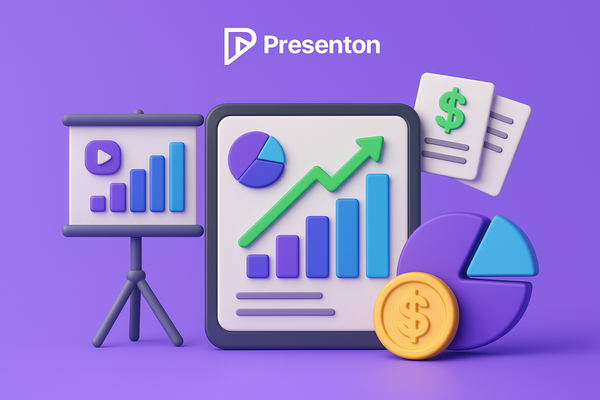The Ultimate Guide to Data Presentation & Visualization

Introduction
Hey there! Have you ever seen a graph or chart that made data super easy to understand? That’s the magic of data visualization! Whether you're presenting a school project, sharing business insights, or just trying to make sense of numbers, using the right tools and techniques can make a huge difference. In this guide, we’ll walk you through everything you need to know to create awesome data presentations. Let’s dive in!
Why Data Visualization Matters
Imagine you have a list of 1,000 numbers. Would you rather stare at them or see a cool graph that tells you the story behind them? That’s why data visualization is so important! It helps us:
- Understand complex data quickly – A well-made graph can explain something in seconds that would take hours to read in a spreadsheet.
- Make data more engaging – People love visuals! Colors, shapes, and charts grab attention better than plain numbers.
- Spot patterns and trends – Ever tried finding a trend in a wall of numbers? It’s tough! But with a graph, trends pop out easily.
- Communicate ideas clearly – A simple pie chart or bar graph can tell a story better than a 10-page report.
Step-by-Step Guide to Creating a Data Presentation
Step 1: Define Your Purpose

Before you start, ask yourself: What am I trying to show? Is it a trend? A comparison? A breakdown of different categories? Knowing your goal helps you pick the right visualization.
Here are some common goals and the best visualizations for each:
| Goal | Best Visualization |
|---|---|
| Compare values | Bar chart, column chart |
| Show trends over time | Line chart, area chart |
| Display parts of a whole | Pie chart, donut chart |
| Show relationships between data | Scatter plot, bubble chart |
| Map geographical data | Heat maps, geo maps |
Step 2: Choose the Right Tool

Now that you know what you want to show, it’s time to pick the right tool. Here are some of the best ones out there:
1. Datawrapper (Best for quick charts)
- Super easy to use
- Great for simple bar charts, maps, and tables
- No coding needed
2. Flourish (Best for storytelling with data)
- Lets you create animated and interactive charts
- Great for reports and presentations
- Free version available
3. Infogram (Best for infographics)
- Lots of cool templates
- Ideal for creating posters, reports, and social media posts
- Easy to share online
4. Google Charts (Best for embedding on websites)
- Free and powerful
- Works great with Google Sheets
- Can create dynamic charts
5. Tableau Public (Best for professional dashboards)
- Advanced features for deep data analysis
- Great for interactive dashboards
- Free version available, but everything is public
6. Microsoft Power BI (Best for businesses)
- Great for analyzing business data
- Works well with Microsoft tools
- More advanced, but very powerful
Step 3: Gather and Organize Your Data

No matter which tool you use, your data needs to be clean and well-organized. Here’s how to do it:
✅ Remove any duplicate or incorrect data
✅ Arrange it in a clear structure (rows and columns work best)
✅ Label everything properly so you don’t get confused later
✅ Keep numbers formatted consistently (e.g., don’t mix percentages with decimals)
A simple rule: If your data is messy, your visualization will be messy!
Choosing the Right Chart Type
Now that your data is ready, let’s pick the right chart! Here’s a quick guide:
1. Bar Charts
Best for comparing values. Use this when you have categories like sales by month or student test scores.
✅ Best for: Comparisons
❌ Not great for: Showing trends over time
2. Line Charts
Perfect for showing trends over time. If your data changes over days, months, or years, this is a great choice.
✅ Best for: Trends
❌ Not great for: Single-point comparisons
3. Pie Charts
Use these to show percentages. If you’re showing parts of a whole (e.g., "What percent of sales came from each region?"), a pie chart works well.
✅ Best for: Proportions
❌ Not great for: Too many categories
4. Scatter Plots
Great for showing relationships between two sets of numbers. Want to see if studying time affects test scores? A scatter plot can help!
✅ Best for: Relationships between numbers
❌ Not great for: Simple comparisons
5. Heat Maps
Use these for geographic data or when you want to highlight patterns. If you're tracking website visitors by country, a heat map makes it easy to see where people are coming from.
✅ Best for: Location-based data
❌ Not great for: Exact numbers
Making Your Presentation Engaging
Once your charts are ready, it’s time to make your presentation awesome! Here are some tips:
Use Colors Wisely
- Stick to 3-5 colors max to keep it simple.
- Use contrasting colors to highlight key points.
- Don’t go overboard with bright neon colors.
Keep Text Simple
- Don’t overload your charts with words.
- Use short, clear titles that explain the main point.
- If needed, add a short description (1-2 sentences max).
Tell a Story
- Instead of just showing data, explain what it means.
- Start with a problem, show the data, and end with a conclusion.
- Example: "Our sales dropped 20% in Q3, but rebounded in Q4 after launching a new campaign."
Keep It Interactive
- If using Flourish or Tableau, let people explore the data.
- Add tooltips so people can hover over points for more details.
- Consider making a short video explaining the key insights.
Common Mistakes to Avoid
🚫 Using too many charts – Keep it simple! Stick to the most important ones.
🚫 Making charts too complicated – If people need a PhD to understand your graph, it’s too complex.
🚫 Ignoring your audience – If your audience is new to data, avoid technical jargon.
🚫 Not labeling your charts – Always add titles and labels!
🚫 Using misleading visuals – Avoid stretching or manipulating graphs to make data look different than it really is.
Final Thoughts
And there you have it! Data presentations don’t have to be boring or confusing. By using the right tools, choosing the best charts, and keeping things simple, you can create visuals that truly tell a story.
Now, go ahead and try out some of these tools! Play around, have fun, and make your data come to life.
Which tool are you excited to try first? Let us know!




